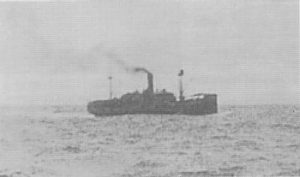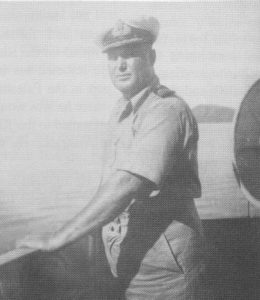- Author
- Ogle, Brian
- Subjects
- Biographies and personal histories, Ship histories and stories, WWII operations, History - WW2
- Tags
-
- RAN Ships
- HMAS Maryborough
- Publication
- December 2001 edition of the Naval Historical Review (all rights reserved)
On March 6th 1942 the Captain of HMAS Maryborough sent the following signal by Aldis lamp:
“Get all those bloody passengers into the stoke hole.” This is recorded in the vaults of Navy Office and also in Lew Lind’s volume “Historic Naval Events of Australia, Day-by-Day.” Commander Cant’s signal was addressed to the Dutch coal burner General Verspijck which Maryborough was escorting from Tjilatjap in Java to Fremantle, weather and the Japanese Navy permitting.

Upon clearing Tjilatjap on March 3rd Verspijck had advised its cruising speed as 8 knots which was a sobering liability in the circumstances. They were amongst the last surviving ships to leave the East Indies and had narrowly escaped being torpedoed outside the harbour. The Japanese army was on the other side of the mountain and the Allies had no army; the Japanese air force was permanently overhead, also without opposition and Nagumo’s fleet of cruisers and escorts was in the Indian Ocean and steaming for Tjilatjap. HMAS Yarra delayed Nagumo by putting up a glorious fight before he sank her. This gave Maryborough and Verspijck a 36 hour start and the chance to get lost in the breadth of the ocean. But you can’t go far in a day at 8 knots.
They were twenty-eight hours south-west with Verspijck rolling along at four knots when the ship’s company heard the sound of an aeroplane engine coming in from the north and the guts fell in every member of the crew. To be located one hundred and fifty miles out in the Indian Ocean on 650 tons of floating steel, inadequately armed, no guns on the convoy and no help within a thousand miles looked to be the end of the road. The plane couldn’t miss them because Verspijck’s funnel was blowing out more black smoke than did a steam loco pulling up the mountains into Valley Heights.
Able Seaman Turner first sighted the plane and called, “Bearing 090 degrees, one Blazing Arsehole,” which was the appellation then current for the emblem of the Japanese rising sun.
It was a long-range seaplane, slow and cumbersome and it kept high out of range. Not in hope, but in rage Maryborough let go with its two pounder pom pom. The first sound of the gun had an extraordinary effect on Verspijck. Within ten minutes she had raised enough steam to shoot past Maryborough at ten knots with her smoke stack discharging more black filth than a modern day environmentalist ever dreamed of on his way up-the-ladder to political fame. At times the old Bunnerong Power Station blacked out Botany Bay; Verspijck took on the vast Indian Ocean in her efforts to shoot through.
Maryborough was in an appalling situation but the moment Able Seaman Turner shouted, “Look at that bastard go!” there was amazement then howls of laughter from bridge to stern. Trouble was the seaplane still circled. Only once did it come lower when it dropped either a bomb or a spare fuel tank which hit nothing but made a very big hole in the ocean. Every minute Admiral Nagumo’s fleet was expected over the horizon in answer to the plane’s signals.
Maryborough couldn’t elevate its four inch, 1908 vintage gun and couldn’t reach with the two pounder, although they had a go. Both ships headed south-west as if on a course to Colombo. After two hours the seaplane ran short of fuel and departed.

At dusk the ocean was still clear of the enemy and there was some hope of escape in the dark. The ships altered course to the east to confuse the Japanese and headed for Fremantle. That night they ran into a cyclone of torrential rain and gale-force winds. In pitch dark, relieved only by lightning flashes, Maryborough pitched, bucked, slewed and screwed as she sought to maintain visual contact with Verspijck. However, even those sailors suffering from sea sickness prayed for the cyclone to continue. They were hidden by its enveloping fury. Around dawn the weather subsided. The sailors bucketed the water out of the mess decks, jettisoned the broken crockery, restored the pots and pans to their rightful places in the galley and tightened up lashings which had been slackened from stem to stern. “Stand-easy”, the first in three days, was no sooner piped than the action station bell sounded. They had an under-water contact bleeping on the Anti-submarine set. An hour’s frantic steaming at full speed around Verspijck, out to starboard, out to port and the contact was lost.




